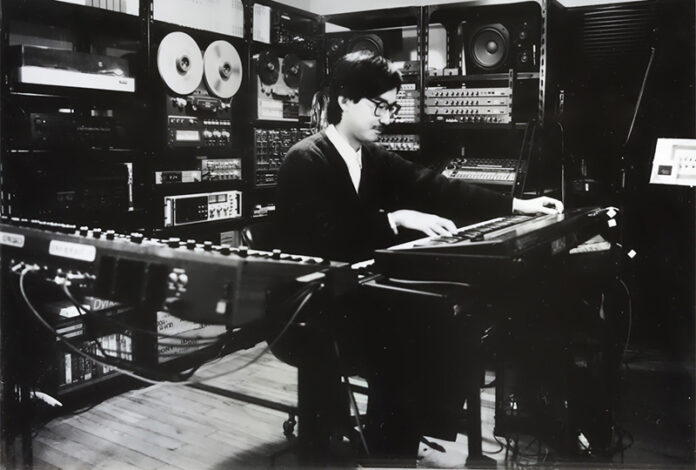In 1983, Japanese ambient patriarch Yoshio Ojima released “Days-Man,” a real-time re-contextualization of shimmery patterns and sound motifs dressed for commercial attention that steer into elongated stretches of abstract rapture. The single from his 1983 album Club didn’t completely sound like a hit should.
Maybe that was the point.
Snares got xeroxed, resembling camera flashes, and simple keyboard refrains are pummeled; then start to dub-out and run in triplicate form. Odd choices become the norm, assembling into new configurations of left-field techno-pop.
Ojima says he was inspired by “fashion, advertisements, buildings, and everything that was overflowing in Tokyo at the time.” In the process, he perfected a melodica temper that could fit as background in a tiny art segment of Oliver Stone’s 1987 film Wall Street, or as the intro music before the Talking Heads hit the stage at their peak. Point is, these normcore patterns eventually move past oversimplification, descending headfirst into austere and hazy environs.
As explained in the liner notes for the Somewhere Between: Mutant Pop, Electronic Minimalism & Shadow Sounds of Japan 1980-1988 compilation, out on the Seattle-based Light In The Attic label, these 14 tracks, including “Days-Man,” highlight deconstructed ideas. The comp brings together sought-after songs that have never been previously released outside of Japan. They resist formal categorization, but do represent Japan’s experimental electronic music period.
That epoch peaked during the 1980s soaring bubble economy. At that time, non-conformist ideas got financed, everyone (but mostly advertising companies) were flush, capitalism bloomed, and home studios came into the picture. The ability to self-release work via affordable media such as cassettes, seven-inch vinyl, and Flexi–discs came online. That flood of cash—similar to a tech boom—allowed parameters to be greatly expanded, and post-commercialism took off.
Much like post-punk dub instrumentals of dance tunes, these eccentric blueprints made exemplary tracks, detaching and reassembling rhythmic ideas. I highly doubt any of these ideas were initially designed for a full-on dance floor, but the feisty spirit of experimentation that emerges from these cutting-edge musicians bringing to life their fever dreams on state-of-the-art technology lead the arrangements directly towards dance floor investigation.
They’re not mainline bumpity-bumps—more like up-the-sleeve daggers that allow DJs to become surgeons on the fly.
Beginning with the moon landing melodies and theremin frequencies generated from the spacey beat-box tendrils of “RNA Organism” by Weimar 22, this is a downtempo moment that happened, and nobody from that genre kept the receipts. Such a rainy day killer mood, it’s about as atmospheric as your living room is gonna get in the hopefully-waning days of COVID. Packed with some vocal inner brain yammer chant, it begs to be visited by beat heads, repeatedly.
“Wha Ha Ha” by Akatere is a searing bucket full of post-punk vigor, in The Slits fashion, that makes great use of a six-minute exploration. Mkawaju Ensembles’ “Tira Rin” works itself into four/four woodblock-xylophone house arrangements and then later re-edits itself, politely ushering us out the door. “Dip In The Pool” by Hasu No Enishi packs all the upright synth-y pop energy that pastel lovers can summon.
But it’s Takami Hasegawa’s “Koneko to Watashi”, two-and-a-half minutes of stunting atmospherics, minimal keyboard rhythmic phrasings, sparse drum machine, and gentle in-your-ear whisperings, that are apt to be heard squarely in the midst of a David Mancuso unmixed set. Or as part of a giant wash wave used by Larry Levan to give “his chirren” a euphoric break. It’s Jan Hammer minus the cocaine. Miami, without the Vice.
Yes, it’s that large of a hang. It takes stones, large ones, to pull it on a packed dance floor, cause it’s a flex. But my God. The reward subsidizes the risk.
Most of these selections have uncertainty built into their core and that’s the attraction of the project. For ideas that shoot for the easy win, go back to that other currently hot ’80s Japanese style City Pop. Not a diss, just factual data.
Those compositions made up of AOR, R&B, jazz fusion, funk, boogie, and disco were designed for monoculture, ease of consumption. But the tracks found on Somewhere Between Mutant Pop, Electronic Minimalism & Shadow Sounds of Japan 1980-1988 were unearthed on Youtube, deep in the algorithm, while one searched for vaporwave snippets to sample. The process recalls the way City Pop was discovered. This time it’s the risk, not the boogie, that remains the guarantee.




